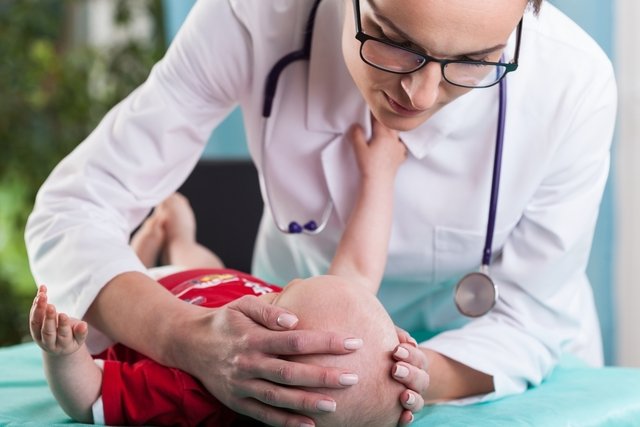Childhood meningitis is a disease that can cause symptoms such as high fever, irritability, lack of response to stimuli and swelling in the fontanelle (soft spot) of babies, and can occur in children of all ages, from newborns to older children. and teenagers.
Childhood meningitis is an inflammation of the membranes that surround the brain and spinal cord, the meninges, and can occur due to infection by viruses, bacteria, fungi and parasites.
Read too: Meningitis: what it is, types, symptoms, transmission and treatment
Treatment for childhood meningitis must be guided by a neurologist and depends on the cause of the meningitis, and the use of antibiotics may be indicated if it is caused by bacteria, or medications to reduce fever and pain in the case of meningitis caused by viruses.

Symptoms of childhood meningitis
The main symptoms of childhood meningitis are:
- High fever;
- Irritability and frequent crying;
- Somnolence;
- Lack of interest in feedings;
- Nausea and vomiting;
- Neck stiffness, in the case of bacterial meningitis;
- Mental confusion and convulsions;
- Increased sensitivity to light;
- Red spots on the skin;
- Swelling in the fontanelle (soft spot), as if there was a bump, in babies up to 1 year old;
- Very severe headache in older children.
The symptoms of meningitis in children can evolve quickly, which is why an evaluation by a neurologist is important. Find the neurologist closest to you using the following tool:
Taking care of your health has never been easier!
How the diagnosis is made
Early diagnosis of meningitis is important to start treatment quickly and minimize the risk of sequelae. Therefore, in addition to evaluating symptoms, the neurologist usually orders some tests, such as a lumbar puncture, blood and urine tests, and imaging tests, such as Computed Tomography or Magnetic Resonance Imaging to determine the impact of inflammation on the child’s brain.
Lumbar puncture is the main diagnostic test, and consists of inserting a specific needle into the child’s back to remove a sample of CSF (cerebrospinal fluid). This liquid is analyzed in order to identify whether there are bacteria, in the case of bacterial meningitis, or other microorganisms that are causing this inflammation in the meninges. Understand how a lumbar puncture is performed.
Main causes
The main causes of childhood meningitis are:
- Bacteria, such as Neisseria meningitidis, Streptococcus pneumoniae, Mycobacterium tuberculosis e Haemophilus influenzae;
- Virus, like enterovirus (Coxsackie and poliovirus), herpes virus, Varicella zoster virus, Epstein-Barr virus and Cytomegalovirus;
- Fungi, as Cryptococcus sp. It is Coccidioides sp.;
- Parasitesas Angyostrongylus cantonesis, Toxoplasma gondii e Tape soles.
The transmission of childhood meningitis occurs mainly through the respiratory tract, through contact with the infected person’s saliva or nasal mucus. Furthermore, it can also happen from direct contact, or with infected objects, and surfaces.
In the case of bacterial meningitis, infection can also occur through contact and/or ingestion of contaminated food. Bacterial infection Neisseria meningitidis It is the main cause of meningitis in children, especially in babies in the first year of life. See more about bacterial meningitis.
In the case of viral meningitis, transmission may occur, for example, when changing the diaper of an infected baby, without correct hand hygiene, and then touching the hands to the eyes or mouth.
Read too: Viral meningitis: what it is, symptoms, transmission and treatment
Treatment of childhood meningitis
Treatment for meningitis in children must be guided by a neurologist and depends on the cause of meningitis.
In the case of bacterial meningitis, treatment involves the use of intravenous antibiotics prescribed by the doctor, choosing the most appropriate one to eliminate the identified bacteria. In addition to antibiotics, it may be necessary to use other medications to control symptoms, such as analgesics, antipyretics and anti-inflammatories.
In viral meningitis, treatment aims to alleviate symptoms, with the use of medication being recommended to reduce fever and pain, in addition to recommending rest and hydration. The use of antivirals may be recommended by the doctor in cases where meningitis is caused by the herpes virus.
As it is a serious illness, if meningitis is suspected, the child is hospitalized so that the development of symptoms can be monitored and treatment can begin as quickly as possible.
Possible sequels
Some possible sequelae of childhood meningitis are:
- Hearing loss partial or complete, due to damage to the auditory nerve;
- Learning difficultiescognitive deficits, seizures or paralysis, in severe cases;
- Developmental delayespecially if the infection has affected important areas of the brain;
- Behavioral changessuch as difficulty concentrating, irritability or mood changes.
The consequences of meningitis do not occur in all children. In general, they happen when the infection is very serious, when treatment is not carried out in the early stages of the disease, or depending on the type of bacteria or virus involved.
Therefore, it is important that the doctor is consulted as soon as the first signs suggestive of meningitis appear so that the diagnosis can be made and treatment can be started, reducing the risk of complications. And, even if there are sequelae, these can be minimized with adequate monitoring by health professionals.
How to prevent childhood meningitis
The main way to prevent childhood meningitis is the vaccine. The vaccines available for the prevention of meningitis are administered when children are still babies, the main ones being: meningococcal vaccine C (Conjugated), pneumococcal 10-valent vaccine (conjugated), pentavalent, meningococcal C (Conjugated) and meningococcal ACWY (Conjugated) . Find out more about meningitis vaccines.
Furthermore, it is important to pay attention to hygiene habits, such as washing your hands to reduce the spread of these microorganisms, and avoiding close contact with people who are suspected or confirmed to have meningitis, in order to reduce the risk of transmission of the disease. illness.




